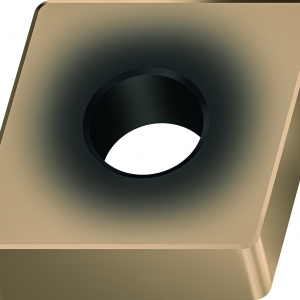Contact Details

With the FW4 and MW4 positive wiper geometries, Walter is introducing two indexable insert geometries for longitudinal turning and facing that combine the “wiper effect” and the new highly wear-resistant Walter Tiger·tec® Gold grades.
The curved wiper cutting edge is a unique feature that makes the wiper action universal across various material groups such as steels, stainless steels, cast irons or even super alloys. The wiper action can be used to reduce machining time by using double the feed rate, while imparting the same surface finish. In some cases, feed rate increases of up to 300% were successfully utilized. A higher feed reduces the amount of time an insert stays in cut, reducing the friction and temperatures seen by the insert, extending tool life and reducing indexing times. Alternatively, an end user can double the surface quality while maintaining the same feed, which is the traditional use of wiper inserts.
The FW4 universal wiper geometry with a narrow chip breaker, which generates short chips, is for finishing operations. The machining parameters for the FW4 geometry are a feed of 0.0012-0.020 in. and a cutting depth of 0.004-0.100 in. The primary application is turning steel, stainless steel and cast iron (ISO P, M and K workpiece groups), and the secondary application is turning super alloys (ISO S workpiece group).
The MW4 universal wiper geometry with an open chip breaker groove and longer radius wiper cutting edge for high feeds is for medium machining.
The machining parameters for the MW4 geometry are a feed of 0.005-0.022 in. and a cutting depth of 0.020-0.180 in. The primary application is turning steel and cast iron (ISO P and K workpiece groups), and the secondary application is turning stainless steel and super alloys (ISO M and S workpiece groups).
Because of the wiper edge with its curved design, improved surface quality, productivity and process reliability is achieved even when the machine tool is not aligned 100 percent precisely, such as if the turret is slightly offset. The new chip breakers also increase the chip breaking range, resulting in less machine downtime caused by the creation of bird nests.
Related Glossary Terms
- alloys
alloys
Substances having metallic properties and being composed of two or more chemical elements of which at least one is a metal.
- cast irons
cast irons
Cast ferrous alloys containing carbon in excess of solubility in austenite that exists in the alloy at the eutectic temperature. Cast irons include gray cast iron, white cast iron, malleable cast iron and ductile, or nodular, cast iron. The word “cast” is often left out.
- feed
feed
Rate of change of position of the tool as a whole, relative to the workpiece while cutting.
- indexable insert
indexable insert
Replaceable tool that clamps into a tool body, drill, mill or other cutter body designed to accommodate inserts. Most inserts are made of cemented carbide. Often they are coated with a hard material. Other insert materials are ceramic, cermet, polycrystalline cubic boron nitride and polycrystalline diamond. The insert is used until dull, then indexed, or turned, to expose a fresh cutting edge. When the entire insert is dull, it is usually discarded. Some inserts can be resharpened.
- stainless steels
stainless steels
Stainless steels possess high strength, heat resistance, excellent workability and erosion resistance. Four general classes have been developed to cover a range of mechanical and physical properties for particular applications. The four classes are: the austenitic types of the chromium-nickel-manganese 200 series and the chromium-nickel 300 series; the martensitic types of the chromium, hardenable 400 series; the chromium, nonhardenable 400-series ferritic types; and the precipitation-hardening type of chromium-nickel alloys with additional elements that are hardenable by solution treating and aging.
- turning
turning
Workpiece is held in a chuck, mounted on a face plate or secured between centers and rotated while a cutting tool, normally a single-point tool, is fed into it along its periphery or across its end or face. Takes the form of straight turning (cutting along the periphery of the workpiece); taper turning (creating a taper); step turning (turning different-size diameters on the same work); chamfering (beveling an edge or shoulder); facing (cutting on an end); turning threads (usually external but can be internal); roughing (high-volume metal removal); and finishing (final light cuts). Performed on lathes, turning centers, chucking machines, automatic screw machines and similar machines.
- wiper
wiper
Metal-removing edge on the face of a cutter that travels in a plane perpendicular to the axis. It is the edge that sweeps the machined surface. The flat should be as wide as the feed per revolution of the cutter. This allows any given insert to wipe the entire workpiece surface and impart a fine surface finish at a high feed rate.











 PRODUCTS
PRODUCTS

